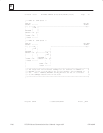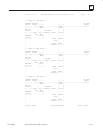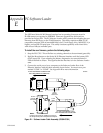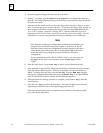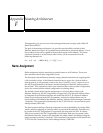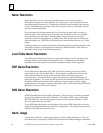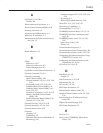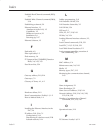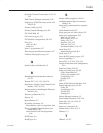
F
F-2
TCP/IP Ethernet Communications User’s Manual - August 1997 GFK-1084B
Name Resolution
Name Resolution involves resolving a symbolic name to its necessary address
information required for communication. Currently today, a user is required to know
this addressing information (i.e., IP address) to establish communication with a remote
device. Name Resolution provides users with a means to also use a Symbolic Name to
reach the remote destination.
For the purposes of this description, the client is the device which needs to resolve a
symbolic name. This symbolic namel represents the IP address of the server. Possible
clients include a user of the Host Communications Drivers and users of the client
capability on the network adapter (e.g., SRTP Client API). Possible servers include the
network adapter (e.g., SRTP Server) and the Host Communications Drivers (e.g., Unsol
Msgs).
Name Resolution of a Symbolic Name into an IP address follows a strict precedence rule.
Local Table resolution is attempted first, followed by DDP, then DNS. Each of these is
described in more detail in the following sections.
Local Table Name Resolution
Local Table Name Resolution involves a simple table lookup to see if a mapping of the
Symbolic Name to its IP Address information exists. Configuration of this table is
described as the third scenario in the Name Assignment section of this Appendix.
DDP Name Resolution
If Local Table Name Resolution fails, DDP (a GE Fanuc Naming protocol) is used to
dynamically resolve the Symbolic Name. This resolution is performed by having the
client node broadcast a message on the network asking if anybody recognizes a
particular name. If someone does recognize the name, they respond and supply the
associated IP address. The client can then proceed with communication directly to that
IP address. DDP uses broadcast traffic to perform name resolution. Certain routing
configurations do not support routing of broadcast traffic, which implies that DDP Name
Resolution will not work over such routers.
DNS Name Resolution
If DDP Name Resolution fails, DNS is attempted. This protocol is an industry standard
for resolving symbolic names to IP Addresses. The format of DNS usage is defined by
RFC 1034 and 1035. Our implementation conforms to the industry standard. A DNS
server is required for this operation.
To use DNS Name Resolution, the IP address of the remote DNS Name Server must be
supplied to the Ethernet Interface in the PLC configuration. The symbolic name must be
defined at the DNS Name Server device.
Name Usage
Various areas of the PLC system support the use of this naming architecture. They can
be broken into two categories: Channel API commands and Station Manager commands.






